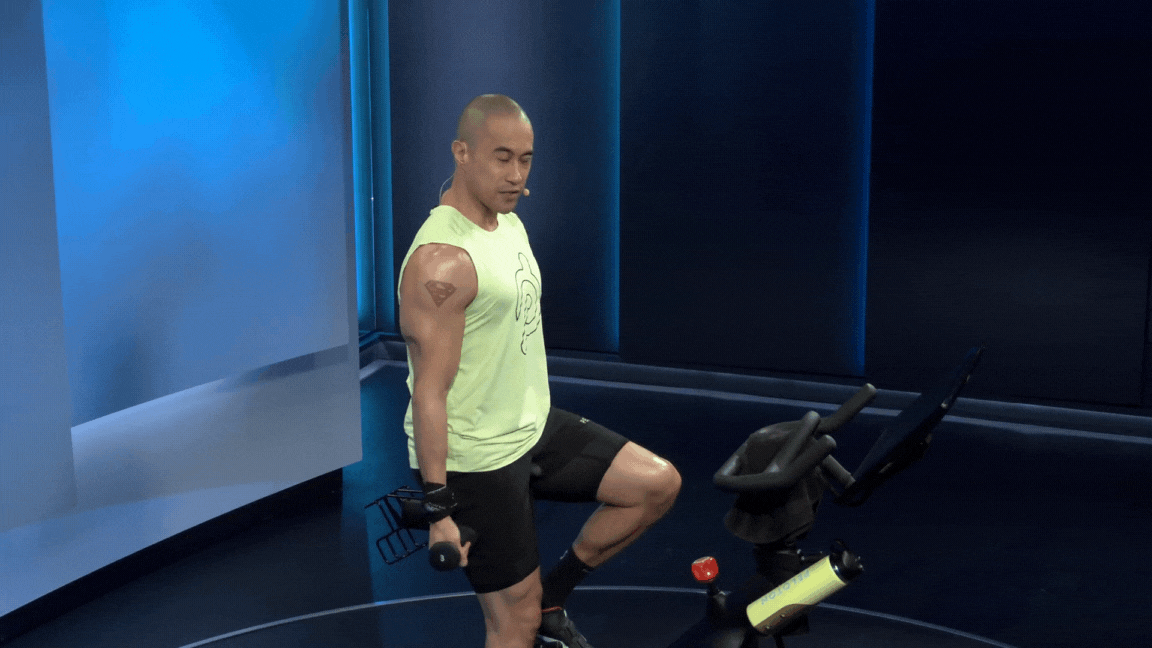
Are Light Weights Enough to Build Strength?
We asked the experts what you need to know about those dumbbells.
By Tiffany Ayuda•
What Are Low-Weight, High-Rep Workouts?
The Benefits of Low-Weight and High-Rep Workouts
The 3 Best Low-Weight, High-Rep Exercises
How Low-Weight, High-Rep Workouts Can Fit Into Your Routine
You’re likely familiar with the benefits of lifting weights: gaining muscle, improving your strength, and even breaking a sweat. But slamming down heavy barbells isn’t for everyone. You may prefer the pace and technique of lower intensity strength-training modalities that use light dumbbells, such as Pilates and barre. But can you reach your full strength potential with low-weight, high-rep workouts?
Discover more ways to reach your goals with Peloton
“When it comes to strength training, nine out of 10 times, this term means lifting the heaviest weights you can in the gym,” says Sam Yo, a Peloton instructor. “But if you don’t want to go ‘full-on beast mode,’ using any load of weights to improve your strength can be beneficial compared to anyone who does nothing at all.”
There’s a place for light weights in your strength routine, but there are limits on how effective they can be for building major muscle power. Here, we break down what this type of training is, its benefits, and how to incorporate it into your workout routine to fit your specific exercise goals.
What Are Low-Weight, High-Rep Workouts?
You’re typically completing a low-weight, high-rep workout when you use a load 67 percent below your one rep-max (1RM), which is one rep of the heaviest weight you can lift for a given exercise, says Domenic Angelino, CPT, lead exercise scientist at Trainer Academy. For example, if your 1RM for a biceps curl is 25 pounds, you may opt for a 8-pound dumbbell for your low-weight, high-rep workout.
“If someone were to recommend training to improve muscular endurance, they may recommend using a light weight for a larger number of reps, such as 12 to 20 reps,” Angelino says. Muscular endurance refers to your muscle’s ability to contract under force for an extended period of time. This differs from maximal strength, which is your muscle’s ability to recruit all motor units (muscle fiber and muscle motor neurons) to create the most tension against resistance.
Your version of “light weights” will change over time as you build strength. As a result, it’s important to pay attention to the intensity of your workout—and how your body responds to it. For instance, squatting a 20-pound dumbbell for the first time may be challenging, but as you continue to train and fortify your muscles, that same exercise feels a lot easier. The weight may even feel lighter.
Can You Build Strength With Light Weights?
Relying on lighter weights and higher reps can help you build muscle and strength, but your progress won’t be as rapid as it would be with heavier loads and fewer reps, Sam says. Heavy weights stimulate muscle growth through fatigue and time under tension. To spur that same muscle growth with light weights, you have to work a lot harder.
If you continue to complete your workouts with lighter dumbbells (defined as less than 67 percent of your 1RM), you will eventually reach a point of such slow adaptation that your progress is minimal, Angelino explains.
“Since the motor units you recruit with lighter weights are pretty small, it’ll feel like you hit a point where you’re not seeing much return on your investment [compared to] training with heavier weights,” he says. It happens with all training methods—there’s a limit to the gains you can make. However, by working exclusively with lighter weights, you may plateau a bit sooner than if you opted for those heavier dumbbells, he says.
The Benefits of Low-Weight and High-Rep Workouts
1. They’re Safer.
Generally speaking, it’s easier to move lighter weights with control than heavier loads, which lowers your overall risk of injury, Sam says. And because light weights place less impact on your joints than heavy weights, you can do more reps with good form—reducing your risk of spraining your ligaments or the tissue around your joints.
2. They Can Improve Your Muscular Endurance.
Low-weight, high-rep workouts build your muscular endurance by increasing the amount of time your muscle is able to contract under force. Your muscles don’t fatigue as quickly as they would with heavier loads, Sam says.
You also may feel your heart rate elevating a bit more than it does with heavy dumbbells. “Doing 12 or more repetitions per set not only benefits your muscular endurance but improves your cardiovascular fitness, due to the duration of an average set being longer than that with heavier weights,” Sam says.
3. They’re Perfect for Beginners.
If you’re a strength-training novice, you may find it easier to maintain consistency in your workout routine with light weights because the exercises feel a bit more doable. A low-weight, high-rep workout is a great starting point in your strength-training journey.

The 3 Best Low-Weight, High-Rep Exercises
Certain types of workouts, such as circuits and “as many rounds as possible” (AMRAP), are well-suited for light weights and high reps because they emphasize muscular endurance, Sam says. Incorporating light weights into bodyweight movements, such as lunges, squats, and biceps curls, is a great way to level up your workouts.
1. Dumbbell Reverse Lunge
Stand with your feet hip-width apart. Hold a light dumbbell in each hand.
Take a big step back with your right leg. Lower both legs until they each form a 90-degree angle. Hold for a second.
Press through your left foot to stand up. Return your right foot to the starting position.
Repeat on the left side.
Muscles worked: Glutes, hamstrings, quads, and calves
2. Dumbbell Squat
Stand with your feet hip-width apart. Hold a pair of light dumbbells in front of your shoulders.
Brace your core. Keep your chest lifted. Imagine you’re about to sit in a chair. Bend your knees and lower your legs toward the floor. Pause when your thighs are parallel to the ground. Avoid caving your knees inward or outward.
Press your feet into the ground to stand back up and return to the starting position.
To practice other lower body exercises using light weights, try a barre class on the Peloton App.
Muscles worked: Glutes, hamstrings, quads, adductors, and core
3. Dumbbell Biceps Curl
Stand with your feet shoulder-width apart. Hold a light dumbbell in each hand, palms facing in toward your body.
Brace your core. Keep your elbows close to your torso. Curl the dumbbells up to your shoulders with control. Squeeze your biceps. Hold for a second.
Slowly lower the weights back down to the starting position.
For an extended low-weight, high-rep workout that includes other strengthening exercises, try a 10-minute Arms & Light Weights class on the Peloton App.
Muscles worked: Biceps
How Low-Weight, High-Rep Workouts Can Fit Into Your Routine
Can your light weights replace your heavy dumbbells? Well, it depends. The truth is, your strength routine should be tailored to your specific goals.
The best thing you can do is to mix and match your strength training with light and heavy loads. This will help you identify which weight level is most effective in helping you reach your goals.
“It’s best to think of light-weight and heavy-weight training as being good at doing different things,” Angelino says. “Some programs warrant heavy-weight training. Some programs warrant light-weight training. Some programs warrant a mix of both. It’s very goal-dependent.”
Whether you’re using light or heavy loads in your training, progress your workouts by increasing the weight by 5 to 10 percent every few weeks, Sam says. Remember: Using the same weights again and again won’t help you build more strength. Your muscles need to be consistently challenged in order to continue to grow.
“If you’re hesitant to increase the weight, try practicing pause reps, adding bands for increased tension, switching the order you do the exercises, or decreasing your recovery time,” Sam says.
When doing low-weight, high-rep workouts, avoid rushing through the exercises and overtraining, Sam says. When you move too quickly, you’re not able to deepen the mind-muscle connection, which is essential for doing exercises with proper form and activating the right muscles.
Regardless of whether you’re lifting heavy or light, make sure to allot for ample recovery time between your strength workouts to avoid taxing the same muscle group on back-to-back days. Your arms, legs, and core will thank you.
This content is for informational and educational purposes only and does not constitute individualized advice. It is not intended to replace professional medical evaluation, diagnosis, or treatment. Seek the advice of your physician for questions you may have regarding your health or a medical condition. If you are having a medical emergency, call your physician or 911 immediately.





